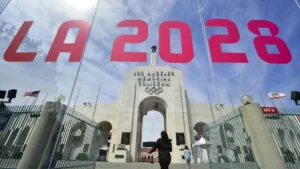The Olympic Games represent a tapestry of customs that bind countries together over time, representing more than just athletic competition. Iconic symbols, like the Olympic rings, function as global representations of cohesion and persistence. In the meantime, the seriousness of the opening and closing ceremonies fosters a sense of respect and unity. These customs, rooted in antiquated customs but advancing with current times, bring spectators and competitors worldwide together to celebrate diversity and human potential. They remind us of our shared past and inspire us to create ties of friendship and unity that cut over national boundaries and cultural divides to create a more global community.
The Rings of the Olympics
Baron Pierre de Coubertin’s Olympic rings are a potent representation of international solidarity and harmony. The five rings were first used at the 1920 Antwerp Games. They represent five continents: blue, yellow, black, green, and red. This symbolizes the Olympic movement’s inclusiveness and global reach. The rings are more than just a visual symbol; they represent a spirit of camaraderie, unity, and fair competition that knows no geographical bounds. The Olympic rings, which represent the common goals of humanity on the global stage, continue to inspire competitors and fans alike as a timeless reminder of the Games’ objective to promote peace and understanding.
The Olympic Flame
The Olympic flame, which has its roots in the Greek tradition, symbolizes the eternal relevance of the Olympic principles and their passing down through the ages. It comes from Olympia, Greece, and is lit by the sun. Torchbearers carry it across continents in a symbolic journey. The official start of the Games is signalled by its arrival at the stadium in the host city for the opening ceremony, inspiring a sense of solidarity and excitement among competitors and spectators alike. In addition to igniting the competitive spirit, lighting the cauldron is a moving reminder of humanity’s shared dedication to excellence and fair play.
Also Read: Non-Olympic Sports That Should Be in the Olympic Games
The Opening Ceremony
The Olympic opening ceremony is a magnificent exhibition of global unity and cultural legacy. While athletes represent their country with a parade into the stadium amid flags flying and anthems playing, host nations use music, dance, and visual art to exhibit their identity. This Parade of Nations promotes goodwill and mutual respect among nations by representing unity amid variety. The ceremony embodies the spirit of the Olympic movement through this spectacle, which celebrates variety, transcends borders, and fosters a sense of brotherhood. It creates the following atmosphere for the competition and brings spectators and competitors together to celebrate human achievement and world solidarity.
The Oath of the Athletes
The attitude of sportsmanship and fair play is embodied in the Athletes’ Oath, which is said during the Olympic opening ceremony. Athletes commit to preserving the moral principles of honesty and decency towards their fellow competitors, emphasizing the group’s quest for perfection more than individual success. This solemn commitment promotes a sense of solidarity among athletes from various origins and represents the camaraderie and mutual respect that define Olympic sport. Inspiring competitors to compete with honour and defend the highest goals of the Olympic movement, the oath emphasizes the Games’ dedication to fostering friendship, unity, and fair competition on the international stage by restating these values.
Also Read: Five Most Controversial Cases in Olympics History
The Ceremonies for Medals
The medal ceremonies represent more than just winning a race, they capture the spirit of the Olympics. At the ceremonies, athletes are recognized for their perseverance and devotion as they proudly stand on the podium with the flags of their countries flying above them. These occasions, marked by national anthems, are a tribute to the solidarity and camaraderie created throughout sport and speak to the ideals of sportsmanship and fair play. Beyond individual victories, the ceremonies guarantee that the Olympic torch of desire burns brightly in the hearts of competitors and spectators alike by encouraging future generations to achieve excellence with honesty and perseverance.
Conclusion
Olympic customs capture the spirit of the Games and represent ideals that people worldwide cherish: camaraderie, excellence, and respect. The athletes’ oath and opening ceremony uphold solidarity and fair play, while the rings and flame represent unity and continuity. Athletes and spectators unite in a communal celebration of human achievement as these rituals create a worldwide link that cuts across boundaries and cultural differences. We honour the enduring spirit of the Olympics by upholding and cherishing these customs, realizing the power of sport to inspire and bring people together despite differences. They remind us of our common humanity and the transforming potential of athletic endeavour, serving as a light of hope and unity.






















